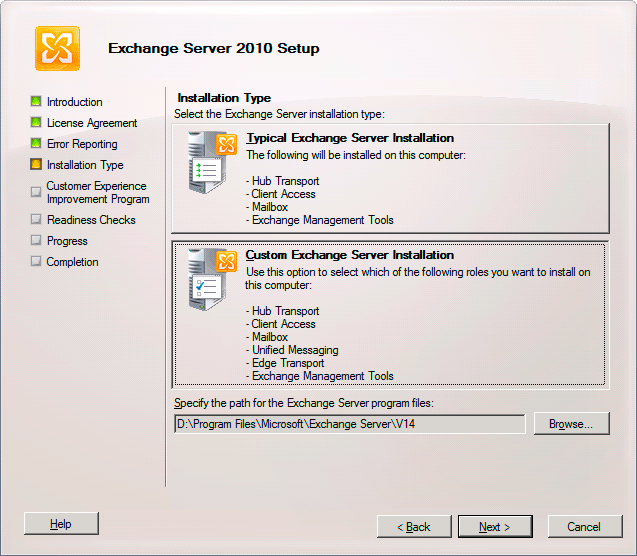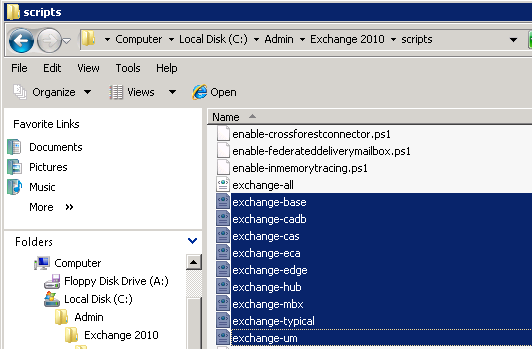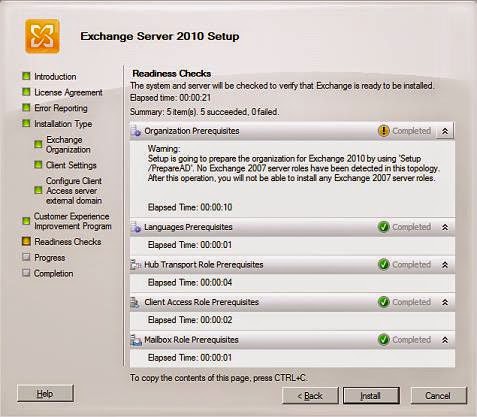Installing Exchange Server 2010 Step-by-Step on Windows 2008 R2 Server
Now Exchange 2010 can be installed on either Windows Server 2008 64-bit with Service Pack 2, or Windows Server 2008 64-bit R2, and either Standard or Enterprise editions.
Perquisites are vary in different version of windows server 2008 SP2 x64 Here we are going to installed on windows server 2008 R2
Perquisites for windows server 2008 sp2 x64 can be seen on my next blog, so let’s start planning and deployment
Make sure your Active Directory (AD) infrastructure and your Exchange server meet the minimum requirements:
- AD forest functional level is Windows Server 2003 (or higher) SP1 recommended
- AD Schema Master is running Windows Server 2003 w/SP1 or later
- Full installation of Windows Server 2008 SP2 or later OR Windows Server 2008 R2 for the Exchange server itself
- Exchange server is joined to the domain (except for the Edge Transport server role)
Installing Exchange Server 2010 Pre-Requisites on Windows Server 2008 R2
In this example we are going to install Exchange 2010 on a Windows Server 2008 R2 operating system. Before installing Exchange we need to install some Windows components. It’s important that you don’t miss anything here because the Exchange 2010 installer does not provide very good feedback if Server 2008 R2 is missing required components.
Install the following software components for Exchange 2010
- .NET Framework 3.5 Service Pack 1
- .NET Framework 3.5 Family Update
- Windows Remote Management and Windows PowerShell 2.0
- 2007 Office System Converter: Microsoft Filter Pack (for Hub Transport and Mailbox Server roles only)
After installing the above run the following command from an elevated Windows PowerShell console which has rights to install Windows components/features. On the Start menu, navigate to All Programs > Accessories > Windows PowerShell
Import-Module ServerManager
For a typical installation of exchange 2010 with the Client Access, Hub Transport, and Mailbox roles run the following command:
Add-WindowsFeature NET-Framework,RSAT-ADDS,Web-Server,Web-Basic-Auth,Web-Windows-Auth,Web-Metabase,Web-Net-Ext,Web-Lgcy-Mgmt-Console,WAS-Process-Model,RSAT-Web-Server,Web-ISAPI-Ext,Web-Digest-Auth,Web-Dyn-Compression,NET-HTTP-Activation,RPC-Over-HTTP-Proxy -Restart
Note that combinations of server roles require different pre-requisites. You can see a complete list of these options here.
If your Exchange server will have the Client Access Server role set the Net.Tcp Port Sharing Service to start automatically
Open PowerShell. Be sure that PowerShell opened with an account that has rights to modify service startup settings.
Set-Service NetTcpPortSharing -StartupType Automatic
Now you may run Microsoft Update to verify the latest updates and patches are applied to the server before proceeding with the Exchange Server 2010 install.
Next we need to install the components from the Exchange 2010 source files contain a series of ServerManagerCmd.exe answer files in XML format that can be used to install the operating system pre-requisites for each of the server roles but we are here installing Typical exchange role on a single server
Each file relates to a specific Exchange 2010 deployment scenario.
- exchange-all.xml – all server roles
- exchange-base.xml – only the requirements for Forest and Domain prep operations
- exchange-cadb.xml – Central Admin Database role
- exchange-cas.xml – Client Access Server role
- exchange-eca.xml – Central Admin role
- exchange-edge.xml – Edge Transport Server role
- exchange-hub.xml – Hub Transport Server role
- exchange-mbx.xml – Mailbox Server role
- exchange-typical.xml – Typical Exchange server (Client Access, Hub Transport, and Mailbox Server roles)
- exchange-um.xml – Unified Messaging role
Execute exchange-typical.xml answer files from the exchange source folder using ServerManagerCmd.exe and the -inputPath parameter (that can be shortened to -ip). Here I am installing the pre-requisites for a “Typical” server.
C:\Admin\Exchange 2010\scripts>servermanagercmd -ip exchange-typical.xml
………………………..
Start Installation…
Skipping [.NET Framework 3.0 Features] .NET Framework 3.0 Features because it is
already installed on this computer.
[Installation] Succeeded: [.NET Framework 3.0 Features] WCF Activation.
[Installation] Succeeded: [Web Server (IIS)] Management Tools.
[Installation] Succeeded: [Web Server (IIS)] Web Server.
[Installation] Succeeded: [Remote Server Administration Tools] Feature Administr
ation Tools.
[Installation] Succeeded: [Remote Server Administration Tools] Role Administrati
on Tools.
[Installation] Succeeded: [Remote Server Administration Tools] Active Directory
Domain Services Tools.
[Installation] Succeeded: [Web Server (IIS)] Performance.
[Installation] Succeeded: [Web Server (IIS)] IIS 6 Management Compatibility.
[Installation] Succeeded: [Web Server (IIS)] Health and Diagnostics.
[Installation] Succeeded: [Web Server (IIS)] Application Development.
[Installation] Succeeded: [Web Server (IIS)] Security.
[Installation] Succeeded: [Web Server (IIS)] Common HTTP Features.
<100/100>
Success: A restart is required to complete the installation.
C:\Admin\Exchange 2010\scripts>
Now we can start installation of Exchange Server 2010.
Exchange 2010 Installation
Now we’re ready to run the Exchange 2010 installer. Through a typical installation that includes the Client Access, Hub Transport, and Mailbox roles. This is what you will want to install if you are only going to be running one Exchange server. If you scale out your Exchange architecture with multiple servers then you will want to familiarize yourself with the Exchange server roles for a proper deployment.
- Logon to the desktop of your soon to be Exchange server with a Domain Admin account.
- Run setup from the Exchange 2010 media.
- Click on “Step 3: Choose Exchange language option” and choose one of the options (Install only languages from the DVD will be fine in most cases).
- Click on “Step 4: Install Microsoft Exchange.”
- Click Next at the Introduction page.
- Accept the license terms and click Next.
- Make a selection on the Error Reporting page and click Next.
- Stick with the default “Typical Exchange Server Installation” and click Next.
- Choose a name for your Exchange Organization and click Next.
- Make a selection on the Client Settings page and click Next.
- If you want your Exchange server to be available externally then choose a domain name such as mail.yourorganization.com, click Next.
- Make a selection on the Customer Experience Improvement Program page and click Next.
- If all the prerequisites are there then you can click Install.
- Grab a cup of coffee or take a walk while the installation process does its thing.
- When the installation has finished go back to the Exchange installation page click on “Step 5: Get critical updates for Microsoft Exchange.”
Install Microsoft Update (if necessary) so that Windows update will check for non-OS updates, and verify that there are no Exchange updates.
Post Installation Steps
Now Exchange 2010 is installed, you will need to do some basic configuration in the Exchange Management console to get mail flowing to/from your server.
- Open the Exchange Management Console via Start => All Programs => Microsoft Exchange Server 2010 => Exchange Management Console
- Expand Microsoft Exchange On-Premises so you can see: Organization Configuration, Server Configuration, Recipient Configuration, and Toolbox
- Under Organization Configuration => Hub Transport => Accepted Domains add a new Accepted Domain for the domain you wish to use for email addresses. For example, your AD domain will be listed by default (i.e. ad.yourorganization.com). You will probably want to add “yourorganization.com” as an Authoritative Domain.
- Under Organization Configuration => Hub Transport => Send Connectors => New Send Connector … => Pick a name such as “Yourorganization Internet Send Connector” => change the drop down to “Internet” => Next => Add … => enter “*” in the Address field and check the box to include all subdomains => OK => Next. Now, if you want your Exchange server to route mail directly, then click Next on the Network setting page, but if you want to route your email through an upstream provider then select “Route mail through the following smart hosts” and Add … a mail gateway such as smtp.comcast.net. Click Next => Next => Next => New
- Under Server Configuration => Hub Transport => Right-click Default *** => Properties => Permission Groups tab, check the box for Anonymous users. This will allow your Exchange server to accept incoming mail delivery from remote mail servers.
- Under Recipient Configuration => Mailbox, create mailboxes for your existing AD users (or create a new user & mailbox)
- New Mailbox … => select User Mailbox => Next => Existing users => Add … => select an existing AD account => OK => Next => specify an alias (e.g. the AD user name) => Next => New
- If you want to use an SSL certificate for Outlook Web App, IMAP, POP, etc. click on Server Configuration and import or create the certificate
Mail Routing Configuration
Now the final piece you need to configure to receive mail is your external DNS records. The method for configuring your DNS records will depend on whether you host your own DNS or have a provider that hosts it for you. Either way you will need to create an “A” record that points mail.yourorganization.com to the IP address of your mail server, and an “MX” record that points yourorganization.com to mail.yourorganization.com. You will also want to make sure that port 25 is open both inbound and outbound to your Exchange server.
Conclusion
All Done! You will now be able to browse to https://mail.yourorganization.com/owa (or https://localhost/owa from the server) and logon via the Web interface to send and receive mail.




